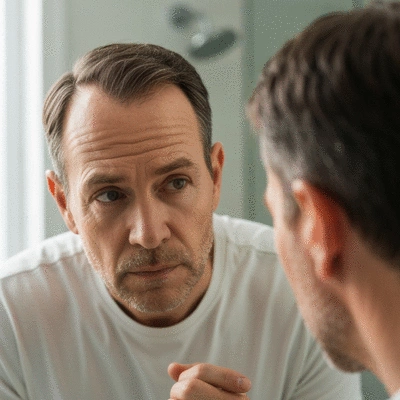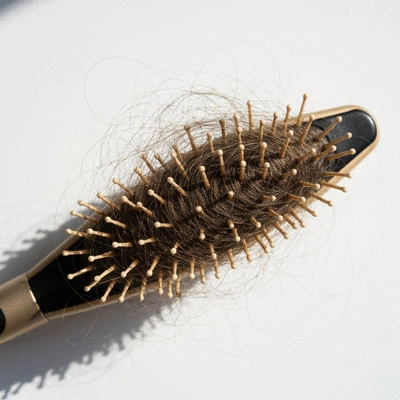Receding Hairline
Often one of the first signs, noticeable as the hairline moves back from its original position.
Recognizing the early signs of hair loss can significantly impact how you manage your hair health. Have you taken a moment to examine your hair lately? Understanding what to look for empowers you to take proactive steps.
Understanding the visual cues of hair thinning can empower you to take proactive steps for your hair health. Here's a breakdown of the primary indicators.
Often one of the first signs, noticeable as the hairline moves back from its original position.
A reduction in hair density at the top-back of the head, impacting overall volume.
Your hair part appears wider and overall hair feels less dense or thinner.
More hair than usual on your brush, in the shower, or on your pillow.
Hair feels brittle, finer, or less vibrant than before.
Persistent irritation, flaking, or redness on the scalp can indicate underlying issues.
Have you ever caught yourself glancing at your hair in the mirror, wondering if it's thinning? Recognizing the early signs of hair loss can be crucial in taking action before it becomes a more significant issue. At What Causes Hair Loss, I want to help you navigate through these visual indicators so you can feel confident about your hair health!
Let’s explore some common visual signs that may indicate your hair is thinning. Being aware of these can empower you to take steps towards maintaining your hair health.
Visual indicators can be some of the first clues that your hair is undergoing changes. By familiarizing yourself with these signs, you can be proactive about your hair care. Here are a few key indicators to pay attention to:
Now, let’s dive a bit deeper into these specific signs to understand them better!
A receding hairline can often feel like an unavoidable reality for many. If you're noticing that your hairline is moving back further than it used to, it's essential to assess this change. For some, this might be a hereditary pattern; for others, it might signal a need for intervention. The International Society of Hair Restoration Surgery provides extensive resources on conditions like androgenetic alopecia, often characterized by a receding hairline.
Knowing how to identify a receding hairline can help you determine the right course of action. Whether it's through lifestyle changes or consulting with a specialist, taking notice early can make all the difference!
Thinning at the crown is another telltale sign of hair loss. This area can sometimes be overlooked, but if you notice a reduction in hair density here, it’s worth paying attention to. Keep an eye on the overall volume of hair you have!
Being proactive about changes in this area can lead to timely adjustments in your hair care routine or treatments that may be beneficial. Remember, knowledge is power when it comes to your hair health!
Does your part seem to be growing wider? This can be a subtle yet significant sign of hair thinning. Many people may not realize that changes in the part can indicate hair loss, so it’s important to remain observant.
In addition, if your hair feels thinner overall, this can also hint at underlying issues. By monitoring these changes, you can take action before it becomes a more prominent concern. Consider keeping a hair journal to track these shifts over time!
While visual indicators are essential, there are also subtle symptoms that may signal that it's time to take a closer look at your hair health. Here are a few symptoms that shouldn’t be ignored:
Recognizing these symptoms early can guide you towards the right solutions. Remember, the sooner you act, the better your chances of maintaining healthy hair!
If you find yourself shedding more hair than usual, it's essential to investigate why. Excessive shedding can stem from various causes, such as stress, hormonal shifts, or nutritional deficiencies. For further information on diagnosing and treating various types of hair loss, including shedding, the American Academy of Dermatology Association offers comprehensive resources.
By keeping an eye on your hair loss patterns, you can make informed decisions about your hair care routine and seek help if needed. Have you noticed any changes in your hair shedding? It might be time to explore some options!
As we age, changes in hair texture can occur, which may not be immediately alarming but are worth noting. If you observe your hair becoming more brittle or fine, this could indicate a bigger issue. Additionally, an increase in scalp visibility can suggest thinning.
Being attentive to these changes can guide your choice of products and treatments. A little investment in understanding your hair can go a long way!
Lastly, don't ignore an itchy or flaky scalp. It can be a symptom of conditions such as psoriasis or seborrheic dermatitis, which can impact hair health. For a deeper understanding of the connection between scalp health and hair loss, research published by the National Institutes of Health highlights various dermatological factors. Taking action on scalp health is just as important as caring for your hair strands!
Regularly check in with your scalp's condition, and don’t hesitate to seek medical advice if you notice persistent issues—it’s all part of taking charge of your hair health.
Did you know that keeping a hair journal can significantly aid your hair health journey? By documenting changes in your hair's condition, shedding patterns, and even your emotional state, you can identify triggers and patterns that may contribute to hair loss. This information can be invaluable when consulting with a dermatologist, helping you make informed decisions about your hair care routine!
The most common early visual signs of hair loss include a receding hairline, thinning at the crown of the head, and a widening hair part accompanied by changes in overall hair density.
Excessive hair shedding is indicated by finding significantly more hair than usual on your brush, in the shower drain, or on your pillow. While some daily shedding is normal, a noticeable increase warrants attention.
Yes, changes in hair texture, such as hair feeling more brittle, finer, or less vibrant than before, can be a subtle symptom of underlying hair loss issues.
Scalp health is crucial. An itchy or flaky scalp can indicate underlying conditions like psoriasis or seborrheic dermatitis, which can contribute to and exacerbate hair loss. Addressing these scalp issues is an important part of maintaining hair health.
Early detection of hair loss is vital because it allows for timely intervention. Recognizing the signs early can help you reverse or significantly slow down the progression of hair loss, leading to more effective management and better outcomes.
As we wrap up our discussion on hair loss, it's clear that early detection and understanding your hair health are crucial steps in preventing further thinning. Recognizing the signs and taking action not only empowers you but also fosters a proactive approach towards maintaining your hair. So, let’s recap some key points and outline the next steps you can take to nurture your hair!
Firstly, remember the importance of regular self-examinations. By keeping a watchful eye on your hair’s condition, you can catch any changes early. Whether it’s noticing thinning areas or changes in texture, awareness is key! Don't forget to take proactive measures like adjusting your diet and lifestyle, which play a significant role in your hair’s vitality.
Early detection of hair loss can make a world of difference in how effectively you can manage it. By tuning into the subtle cues your hair provides, you stand a better chance of reversing or slowing down the process. Here are some preventive measures to consider:
Implementing these strategies can dramatically enhance your overall hair health. When you combine these practices with early detection, you are taking significant steps towards reclaiming the confidence that comes with a healthy head of hair!
I encourage you to create a routine that includes self-examinations of your hair. Make it a habit to check for any signs of thinning or changes. If you notice anything concerning, don’t hesitate to reach out to a professional. Consulting a dermatologist, like myself, can provide you with personalized advice tailored to your unique hair situation.
Additionally, consider keeping a hair journal to document any changes. This can help you track your hair’s condition over time and identify patterns that may require attention. Have you ever thought about how valuable this information can be during consultations? It’s like having your own hair health history at your fingertips!
Starting your journey towards healthy hair can feel overwhelming, but you don’t have to navigate this path alone! There are a plethora of resources available to support you every step of the way. Let’s explore some tools and communities that can make a difference.
In today's digital age, diagnostic tools and technologies are more accessible than ever. These tools can help you monitor your hair health effectively. Consider using:
Using these resources allows you to stay informed about your hair’s condition and the factors affecting it! This proactive stance can be instrumental in spotting issues before they escalate.
Hair loss can be an emotionally challenging experience, and connecting with others who understand your journey can provide immense support. Look for online forums or local support groups where you can share experiences, ask questions, and get advice. It’s empowering to know you’re not alone in this!
Being part of a community can also help dispel any myths you may encounter. Together, you can navigate the misconceptions surrounding hair loss and focus on empowering each other with factual information. Remember, it’s all about taking control and being informed!
As you embark on this journey, it’s important to be aware of common hair loss myths. Here are a few key ones to keep in mind:
By educating yourself on these myths, you can make informed decisions about your hair health and avoid unnecessary worry. Remember, knowledge is power!
Here is a quick recap of the important points discussed in the article:
At What Causes Hair Loss, we unravel the complexities of hair loss with science-backed insights, empowering you with dermatologist-reviewed guides and effective solutions for your hair health journey.
Dermatologist-Reviewed Insights


